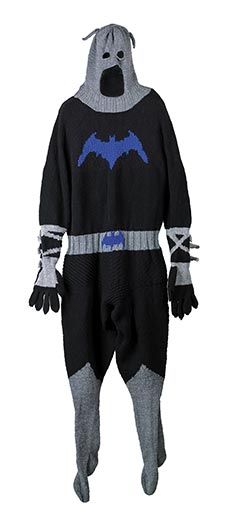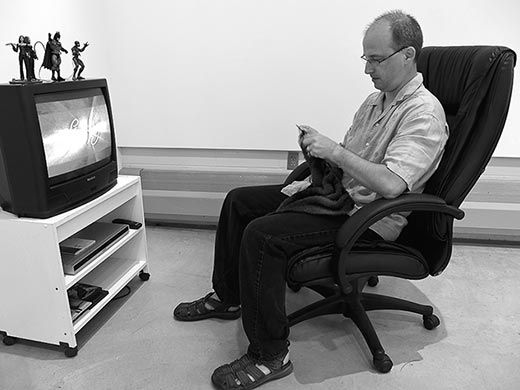Q and A: Mark Newport
Costume designer Mark Newport talks about knitting outfits for superheroes, both famous (Batman) and unknown (Sweaterman)
/https://tf-cmsv2-smithsonianmag-media.s3.amazonaws.com/filer/Mark-Newport-631.jpg)
Flashy capes and skintight garments are the usual accouterments of comic book superheroes. But artist Mark Newport has some fun with these larger-than-life characters with his soft, hand-knit costumes, which are on view through January 3 at the Renwick Gallery’s “Staged Stories: Renwick Craft Invitational 2009.” He spoke with the magazine’s Jordan Steffen.
When did you get interested in superheroes?
When I was a kid I would draw and paint stuff. Sometimes I would copy images out of comic books. I read comic books, but I wasn’t a big collector. In 1997, I started using them in my work. First it was the real materials like the comic book pages and their covers. There’s one of the pieces from that group of work in the show, the “Freedom Bedcover” piece, where I embroidered over several pages of a comic book, and then put them together in the quilt. The piece deals with the idea of the role model and protection.
You have a degree in fine arts from the Kansas City Art Institute, and a master’s degree in fine arts from the Art Institute of Chicago. Along the way, who inspired you as an artist?
When I was in school my teachers were the most inspiring people. In Chicago, Anne Wilson and Joan Livingstone and in Kansas City, Jane Lackey all made work I was interested in. As teachers they were challenging and really committed to their work. That was very inspiring.
Superheroes are symbols of strength, but your costumes are knitted.
Knitting is a very slow technique. That contradicts the idea of a superhero as a man or woman of action. The superheroes that I make are generally male superheroes. I like the contradiction that most people think about knitting as related to women. Also there’s a practical reason: a knit garment stretches more than a woven textile. It’s more functional.
Who taught you how to knit?
I learned to knit twice. The first time was when I was a kid and my grandmother, who was a first grade school teacher, taught me. I think I was ten or something. I probably forgot because there were no knitting needles or yarn at home. In 2000, I wanted to include knitting in some undergraduate classes I was teaching. My wife is a knitter. She gave me a couple books and said, “Here get to it.” The first thing that I had to do was learn how to make a couple of different things. I could knit and create cables and stuff, but I hadn’t made any functional garments. So I made a pair of socks and a pair of gloves. Once I learned to knit in the round, it all made sense.
You display your costumes hanging loosely, instead of on mannequins?
Knit costumes stretch and sag. They take on a completely empty look that challenges the image of the big muscular superhero body. And by displaying the costumes on a hanger, it’s like they’re in a closet. Anybody can imagine putting on the costumes and taking on that superhero role. What does that mean and how does that affect who you are and what you do?
Do you have a favorite?
Batman. For the most part, I identify more with the “make-yourself” type of hero as opposed to the ones who have their powers thrust upon them or magically given to them. That’s more interesting to me. It mimics the idea of how we can take care of the people around us through mundane, human roles.
Do you have a favorite original costume?
Sweaterman is the one I return to the most. Usually that’s because that series explores the different textures and patterns of knitting. He is an easy, open-ended kind of superhero. In reality, my favorite costume is usually the one I’m working on. That’s what I’m most obsessed with and interested in.

